M728 Combat Engineer Vehicle
| M728 CEV (Combat Engineer Vehicle) | |
|---|---|
.jpg) A D7 Mine Plough-equipped M728 Combat Engineer Vehicle (CEV) of the Singapore Army. | |
| Type | Military engineering vehicle |
| Place of origin | United States |
| Service history | |
| In service | 1965–present |
| Used by | See operators |
| Wars |
Cold War Vietnam War Gulf War Bosnian War |
| Production history | |
| Designer | US Army Engineer Research & Development Laboratories [1] |
| Designed | 1963 |
| Manufacturer |
Detroit Arsenal Tank Plant, Warren, Michigan Anniston Army Depot, Alabama[2] (final assembly) |
| Produced |
M728: 1965-1972 M728A1: 1982-1987 |
| No. built | 312 (all variants)[3] |
| Variants | See variants |
| Specifications | |
| Weight |
M728 Combat Loaded: 52.2 short tons (47.4 t) M728A1 Combat Loaded: 53.2 short tons (48.3 t) |
| Length | Overall: 8.83 metres (29 ft 0 in) |
| Width | 3.66 m (12 ft 0 in) |
| Height | 3.3 m (10 ft 10 in) |
| Crew | 4 (commander, gunner, loader, driver) |
|
| |
| Armor |
Upper Hull Glacis M728 / M728A1: equals 10 in (250 mm)[4] |
Main armament |
Main gun: 1× 165mm M135 (30 rounds) |
Secondary armament |
Coaxial machine gun: 1× 7.62mm M240 machine gun (2,000 rounds) Commander cupola: 1× 12.7mm M85 machine gun (600 rounds) |
| Engine |
Continental (now General Dynamics) AVDS-1790-2DR V12, air-cooled twin-turbo diesel engine 750 horsepower (560 kW) |
| Power/weight | 14.1 hp/t |
| Payload capacity |
A-frame crane boom: 9.0 short tons (18,000 lb) hoisting/lifting capacity Winch: 11.0 short tons (22,000 lb) pulling capacity |
| Transmission | CD-850-6A 2 speeds forward, 1 reverse |
| Suspension | Torsion bar suspension |
| Ground clearance | 463 mm (1 ft 6.2 in) |
| Fuel capacity | 1,457 litres (320 imp gal; 385 US gal) |
Operational range | 280 miles (450 km) |
| Speed | 30 miles per hour (48 km/h) |
The M728 Combat Engineer Vehicle (CEV) is a full-tracked vehicle used for breaching, obstacle removal, transportation of demolition teams, and pioneering operations. Production commenced in 1965 and ceased in 1987. A total of 312 of all variants of these armored engineer vehicles were produced.[5]
Design
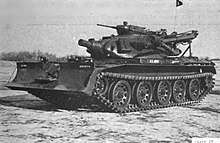
Development and Production
Prototype development began in the late 1940s at Ft. Belvoir, VA by the US Army Engineer Research & Development Laboratories in conjunction with Chrysler. These early T39 Demolition Tank prototypes were based on the M26 using several different modified turrets, demolition guns and heavy mortars. The T118 prototypes used the T95 hull beginning in 1960. Both prototypes went through extensive testing at the Aberdeen Proving Grounds through 1963 and final trials in 1964. The T118E1, with a modified M60A1 turret was then accepted into service as the M728 in 1965 and achieved operational capability in 1968.[6] The turrets for the M728 were manufactured at Chrysler Corp.’s Detroit Arsenal Tank Plant, Warren, Michigan. Final assembly and mating to the vehicle hulls was performed at Anniston Army Depot in Alabama.[7] Initial production of the M728 was from 1965 to 1972. Many of the M782A1s were former M60A2 Patton tanks converted to M728A1s from 1982 to 1987. All M728A1s were converted and assembled at the Anniston Army Depot under contract with General Dynamics Land Systems[8] with a total of 312 of all variants produced.[9][10]
Vehicle Description
The M728 is a full-tracked combat engineer vehicle is designed to provide maximum ballistic protection for the crew and is heavily armed derivative of the M60 series tank modified to provide a mobile and maneuverable weapon for combat support of ground troops and vehicles. The M728 vehicle is used for breaching, obstacle removal, transportation of demolition teams, and pioneering operations. Although the M728 consists of a tank hull and a short-barreled turret, it is not a tank and should not be routinely used against enemy tanks. It is an excellent heavy assault support vehicle when used as part of a combined engineer-infantry team. The CEV is issued two per Engineer Company in the Heavy Division, two per Engineer Company in Corps (Mechanized), three per Engineer Company in Armor/Infantry Separate Brigades and three per Engineer Company in the Armored Cavalry Regiment.
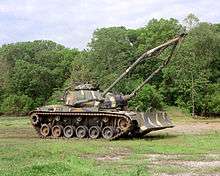
It is usually equipped with either a hydraulically operated M9 Dozer Blade Assembly or a D7 Mine Plough. The M9 Dozer Blade Assembly is used for clearing the way, filling depressions, leveling ground and for other purposes. The D7 Mine Plough is a V-shaped plough that performs countermine activities by lifting buried mines and pushing them to the side as the vehicle moves forward. A winch and retractable A-frame crane are mounted on the turret for lifting, carrying and winching operations. The hull front contains the driver's compartment, controls and instruments. The hull rear contains the engine, transmission, fuel tanks, and related automotive parts. The turret has positions for the commander, gunner, and loader.[11] The vehicle is also equipped with a NBC protection system for the crew. It can produce a limited smokescreen by dumping raw diesel fuel into the exhaust system to visually obscure the area around the vehicle as well as provide a limited vehicle recovery capability.[12]
Weapon Systems
The vehicle is armed with a 165mm M135 short-barreled demolition gun with 30 rounds of HEP (high explosive, plastic) ammunition. The M135 is a license-built copy of the 165 mm L9A1 gun that was used on the British Army's FV4003 Centurion Mk.5 AVRE (armoured vehicle Royal Engineers) tank. Depending on the usage, the gun can be depressed and elevated against targets up to an effective range of 925 metres (1,012 yd). The gun's primary purpose is for clearing defensive fixtures and obstacles, such as walls, fences, roadblocks and bunkers, or for destroying buildings and is generally not meant to be for use in anti-personnel or anti-tank warfare. The pushing and heaving effects caused by the HEP round's base detonating fuze and large amount of explosive can demolish barriers and knock down walls. One round creates a 1 foot (0.3 m) diameter hole in a 7 inch (178 mm) thick reinforced concrete wall. The round's effects against bunkers and field fortifications are dramatic, often crushing or smashing entire walls. The gun fires two types of fixed ammunition, the M123E1 HEP Round and the M623 Target Practice Round. The main gun has a coaxial 7.62×51mm NATO M240E1 machine gun, with 2,000 rounds of 7.62mm ammunition. In addition, a .50 caliber M85 machine gun is mounted in the commander's cupola; this has 600 rounds of ammunition.
Service History
United States
It was first deployed in 1968 during the Vietnam War.[13] The M728 was used in fire support, base security, counter ambush fire, direct assault of fortified positions, and limited reconnaissance by fire.[14] They were also deployed at this time to West Germany during the Cold War to support combat engineer operations and participated in annual REFORGER exercises until 1991.
A mine clearing rake was specially designed and fabricated for the CEV in Operations Desert Shield and Desert Storm. The full width rake allows the CEV to clear minefields in non-cohesive, granular soils. The Mine Clearing Rake is a V-shaped tined plough that performs countermine activities by lifting buried mines with its tines and pushing them to the side as the vehicle moves forward. Attached to any M728 CEV's D7 Mine Plow or M60 series tank via a M9 Dozer Blade Assembly, the Mine Clearing Rake also utilizes an aluminum skid shoe, which protrudes from the front of the tines and allows the rake to maintain a consistent plowing. It clears a path measuring 180 inches wide, accommodating heavy tanks and other armored vehicles. The rake's operations are limited to soft sandy soil. Additional features are that it weighs 4000 pounds, and is easily assembled and installed.[15]
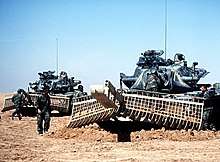
They were active during the Desert Shield phase of the Gulf War in clearing suspected minefields, creating temporary defensive fighting positions and staging areas in the deserts near the Iraqi Saudi border. The M728A1s of the 24th Infantry Division and US XVIII Airborne Corps breached the openings for the "Left Hook" flanking of Iraqi forces during the Desert Storm phase of the war, but they were left behind once they began the pursuit and exploitation phase of the operation[16]. A CEV of the 6th Battalion, 6th Regiment, 1st Armored Division, fired 21 M123E1 rounds into the stubbornly defended town of Al Busayyah: “That totally destroyed all the resistance in the town,” according to the battalion commander.[17] After the cease-fire, CEV guns were used to break up coke piles that had formed around approximately 20% of the burning oil wells in Kuwait. According to the US Army, the guns reduced the time to break up coke formation from as long as two days to 15 minutes. Commanders were unanimous in their opinion that the engineer force needs an M1 chassis based vehicle for heavy breaching and gap crossing equipment to fully support the M1 Abrams and M2 Bradley vehicles.[18].
US Army M728A1s were deployed in support of the United Nations' Resolution, NATO led Implementation Force (IFOR) in 1995. Their initial mission was to protect and demine the international airport at Sarajevo. By September their mission had expanded to include protecting humanitarian aid and assist relief delivery in the whole of Bosnia and Herzegovina, as well as to help protect civilian refugees when required by the Red Cross.[19][20]
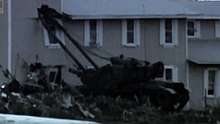
M728s have been temporally acquisitioned for use by the United States Department of Justice's FBI and ATF SWAT teams in the early 1990s to conduct potentially dangerous operations. In particular, it has become associated with the 1993 Siege of Waco, Texas, being caught in dramatic fashion on video and media coverage during the siege.[21] They were provided to the ATF by the Texas Army National Guard from Ft. Hood. They were used to destroy perimeter fences and structures and to crush the cars of people on the compound.
The M728 has been determined by the Army to be inadequate to fully support the M1 Abrams and M2 Bradley vehicles, also cited were the rising costs to maitain and difficulty in acquiring parts for a low density piece of equipment and was retired from combat use with no clear replacement in 2000. In the late 1990s, the Army decided it could not afford to continue developing complicated, maintenance-heavy vehicles for this purpose. The M1 Grizzly program was canceled in 2001, and the prototype developed never went into full production. The Marine Corps however persisted and funded its own development and testing of the M1150 Assault Breacher Vehicle. As of 2009 it is still used by the Army National Guard and US Army Reserve.
Other Users
The 8 M728s formerly in service with the Singapore Army were retired in 2016, having been replaced by the Leopard 2-based "Pionerpanzer 3 Kodiak" Armoured Engineer Vehicle (AEV).[22].
The Spanish Army began the Programa Coraza - 2000 (Program Armor - 2000) in March 1995. One of its goals was the development of a new combat engineer vehicle, the CZ-10/25E Alacran, based on the M60A1 hull and converted from former M60A3 Patton MBTs with upgrades to the engine. It has an external appearance similar to the M728 CEV, but without the 165mm demolition gun, being replaced by a special backhoe. It also has a frontmounted dozer blade and is armed with a machine gun. An initial batch of 38 vehicles have been produced in close liaison with Engineers at the Army Logistics Command.[23]
They continue in service with the armies of a few other countries including Morocco, Portugal and Saudi Arabia.
Variants
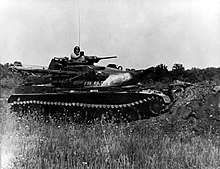
Operators






Former Operators

See also
References
- Notes
- ↑ https://digital.library.unt.edu/ark:/67531/metadc16992/m2/1/high_res_d/BRAC-2005_03371.pdf
- ↑ https://digital.library.unt.edu/ark:/67531/metadc16992/m2/1/high_res_d/BRAC-2005_03371.pdf
- ↑ http://www.military-today.com/engineering/m728_cev.htm
- ↑ Jane's Tank Recognition Guide, 1996, ISBN 0-00-470995-0
- ↑ http://www.military-today.com/engineering/m728_cev.htm
- ↑ Tank Data, vol. 3. Aberdeen Proving Ground, MD: US Army Ordnance School, Jul 1968.
- ↑ Hunnicutt 1984, pp. 439–443
- ↑ https://digital.library.unt.edu/ark:/67531/metadc16992/m2/1/high_res_d/BRAC-2005_03371.pdf
- ↑ http://www.military-today.com/engineering/m728_cev.htm
- ↑ https://fas.org/man/dod-101/sys/land/m728.htm
- ↑ https://fas.org/man/dod-101/sys/land/m728.htm
- ↑ http://www.inetres.com/gp/military/cv/eng/M728.html
- ↑ Decker, Oscar C. "The Patton Tanks: The Cold War Learning Series." Camp Colt to Desert Storm: The History of U.S. Armored Forces. Eds. George F. Hofmann, Donn A. Starry. USA: University Press of Kentucky, 1999
- ↑ http://www.inetres.com/gp/military/cv/eng/M728.html
- ↑ https://www.globalsecurity.org/military/systems/ground/m728.htm
- ↑ Foss, Chris. Modern Tanks. Glasgow: HarperCollins Publishers, 1995
- ↑ http://what-when-how.com/military-weapons/combat-support-and-service-vehicles-military-weapons/
- ↑ https://www.globalsecurity.org/military/systems/ground/m728.htm
- ↑ http://www.military-today.com/engineering/m728_cev.htm
- ↑ https://www.revolver.com/page/Bosnian-War
- ↑ FIRE INVESTIGATOR'S CIVIL SUIT AFFIDAVIT ON ORIGIN OF APRIL 19, 1993 FIRE AT MOUNT CARMEL
- ↑ armstrade.sipri.org/armstrade/
- ↑ http://ciar.org/ttk/mbt/armor/armor-magazine/armor-mag.1998.ma/2spain2000.pdf
- ↑ https://world-defense.com/threads/engineering-vehicles.2122
- 1 2 3 "SIPRI arms transfer database". Stockholm International Peace Research Institute. Information generated on 14 November 2011. Retrieved 14 November 2011. Check date values in:
|date=(help) - ↑ COMBAT ENGINEER VEHICLE 6 M728 Authorized to Supply:6/21/2005 Archived 2013-07-30 at the Wayback Machine.
- ↑ https://world-defense.com/threads/engineering-vehicles.2122/
- ↑ Lewis, Jeff, and Joe D. M60 Spotters Guide, version 2. 5 Aug 2007. 5 Dec 2007 <http://www.com-central.net/index.php?name=Downloads&get=306>
- ↑ armstrade.sipri.org/armstrade/
External links
| Wikimedia Commons has media related to M728 Combat Engineer Vehicle. |